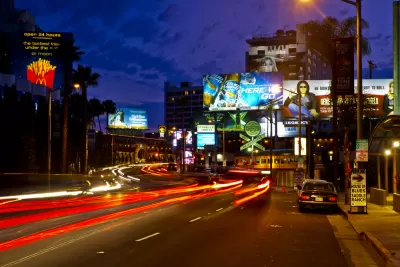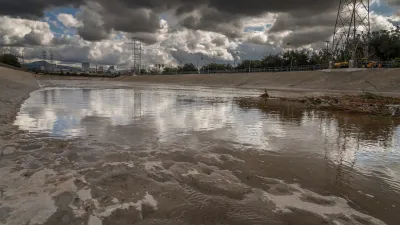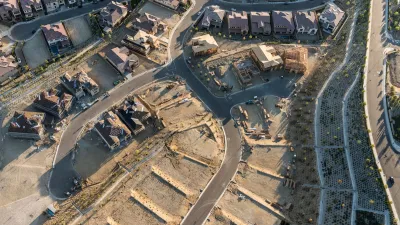Los Angeles appears in Blade Runner 2049 in name only. But the film still provides an arresting vision of a high-density future and is a reminder of the eternal ambiguity that surrounds Los Angeles.

"Blade Runner created a dystopic vision of Los Angeles that remains as culturally potent today — if not more so — than it was when it came out in 35 years ago. It shows up in books, articles, and offhand remarks with astounding regularity. It’s a testament to the arresting visuals of hyper-dense polyglot streets illuminated by sparkling advertisements and the possibility, however slim, that our sunny, spread-out paradise could, someday, become one of the dark places of the earth. After all, perhaps the biggest fantasy to come out of Los Angeles is Los Angeles itself."
"Areal shots depict the city’s familiar endless rows of boulevards and residential streets. The houses that dot Reyner Banham’s Plains of Id are replaced by high-rise shantytowns, made up of apartment buildings, each many stories tall, each more dilapidated than the last. Mere dingbats they are not. In this Blade Runner, the billboards walk the street, as 80-foot tall holograms that shake their asses just for you. (We’ve come a long way from Angelyne.) Skyscrapers rise into the ochre fog, and all is overshadowed by the new citadel of the Wallace Corporation, the corporation that rose from the ashes of Tyrell."
"Interestingly, of all the reasons that Scott might have envisioned for the demise of the world, climate change surely was not one of them. Blade Runner came out in 1982, after all. If anything, he probably had in mind the Cold War, signified by passing references to our them-communist antagonists, Russia and China. So, while the fictional city hasn’t changed much, its allegorical power has changed dramatically, as the real threats to humanity have evolved (and, arguably, worsened)."
FULL STORY: Searching for Los Angeles in Blade Runner 2049

Planetizen Federal Action Tracker
A weekly monitor of how Trump’s orders and actions are impacting planners and planning in America.

San Francisco's School District Spent $105M To Build Affordable Housing for Teachers — And That's Just the Beginning
SFUSD joins a growing list of school districts using their land holdings to address housing affordability challenges faced by their own employees.

The Tiny, Adorable $7,000 Car Turning Japan Onto EVs
The single seat Mibot charges from a regular plug as quickly as an iPad, and is about half the price of an average EV.

With Protected Lanes, 460% More People Commute by Bike
For those needing more ammo, more data proving what we already knew is here.

In More Metros Than You’d Think, Suburbs are Now More Expensive Than the City
If you're moving to the burbs to save on square footage, data shows you should think again.

The States Losing Rural Delivery Rooms at an Alarming Pace
In some states, as few as 9% of rural hospitals still deliver babies. As a result, rising pre-term births, no adequate pre-term care and "harrowing" close calls are a growing reality.
Urban Design for Planners 1: Software Tools
This six-course series explores essential urban design concepts using open source software and equips planners with the tools they need to participate fully in the urban design process.
Planning for Universal Design
Learn the tools for implementing Universal Design in planning regulations.
Smith Gee Studio
City of Charlotte
City of Camden Redevelopment Agency
City of Astoria
Transportation Research & Education Center (TREC) at Portland State University
US High Speed Rail Association
City of Camden Redevelopment Agency
Municipality of Princeton (NJ)





























